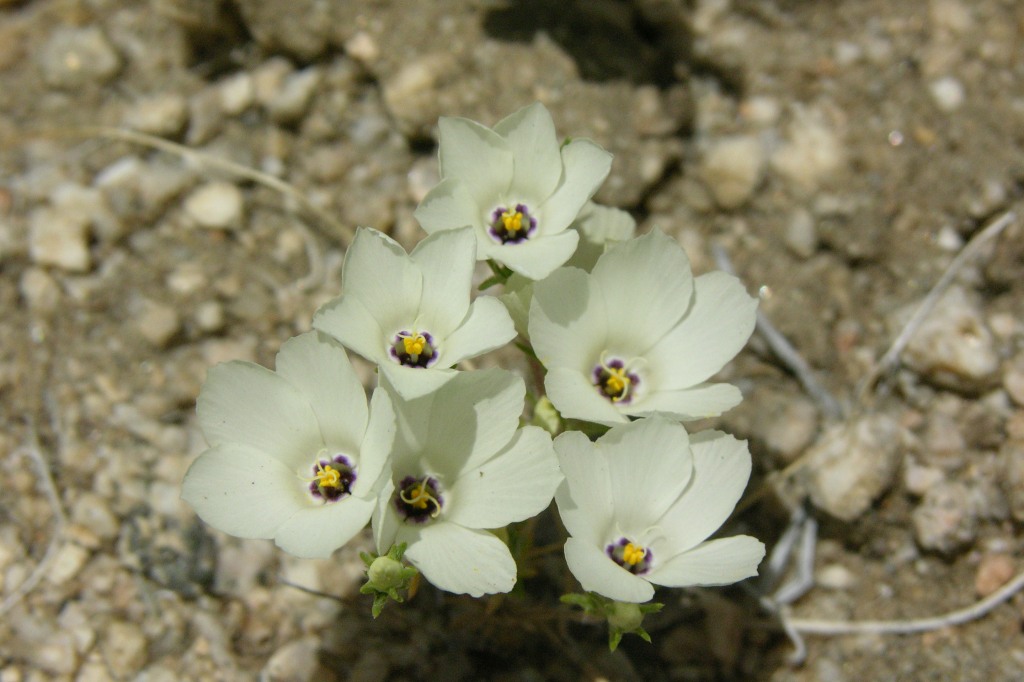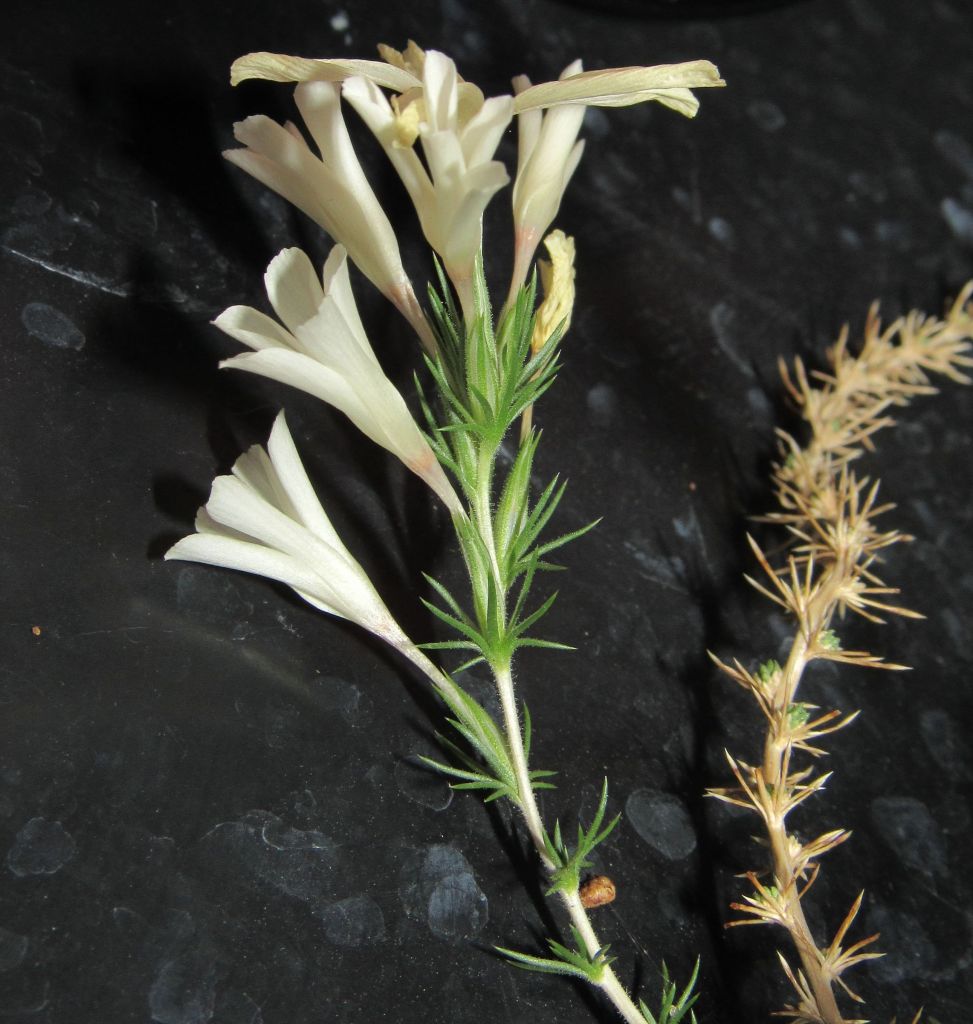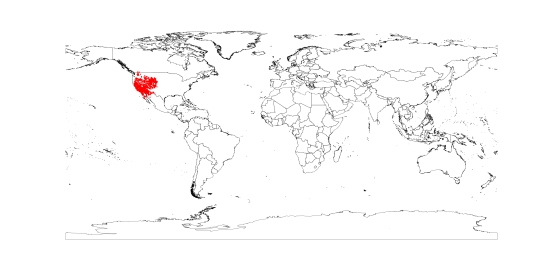Linanthus is a genus of 26 species of diminutive annuals and shrubs endemic to western North America. Once much more broadly circumscribed, many species of what where once considered Linanthus are placed in the molecularly but perhaps morphologically indistinct genus Leptosiphon. Indeed, as Bell & Patterson (2000) note, a “dearth of dependable, easily measured morphological characters in Linanthus has hampered attempts to reconstruct the [its] phylogeny.” The genus Leptodactylon, a name applied to spinescent shrubs, appears to be embedded within Linanthus. These shrubby members of Linanthus are often confused with Phlox. However, they differ substantially in having leaves which are compound and alternate around the stem, anthers inserted at one level in the corolla tube, and many-seeded capsules which are not explosively dehiscent.
Phylogeny
The species assigned to in Linanthus in the taxonomic section are monophyletic with the exception of L. inyoensis, which is clearly sister to Gynmosteris (Johnson et al., 2008). Molecular phylogenetic evidence places Linanthus sister to a clade consisting of Gymnosteris, Leptosiphon, Microsteris, and Phlox. Relationships within Linanthus are generally poorly supported (Bell et al. 1999; Bell & Patterson 2000). Johnson et al. (2008) did recover several well-supported clades within Linanthus, but this may have been a result of artificially high support from poor taxonomic sampling or from support from indels rather than nucleotide substitutions. Nevertheless it is clear that perennial Leptodactylon is embedded in Linanthus (where it may or may not be monophyletic, viz. the position of L. jaegeri).
Biogeography
With one exception (L. dichotomus), all annual species of Linanthus are restricted to the southwestern United States and Baja California, Mexico. By contrast, the perennial members of Linanthus (Leptodactylon) are widespread in arid and montane regions of the western United States, especially L. pungens.
The chronogram of Bell and Patterson (2000) suggests that Linanthus had diversified by the Pliocene between 5 and 1.2 mya. Furthermore, internal branch lengths suggest rapid radiations. This diversification may have been driven by a drying climate as well as the opening of new microhabitats as the Sierra-Nevada rose to their current height (Bell and Patterson 2000).
Taxonomy
- Linanthus arenicola (M.E. Jones) Jeps. & V. Bailey
- Linanthus bellus (A. Gray) Greene
- Linanthus bernardinus N.S. Fraga & D.S. Bell
- Linanthus bieglovii (A. Gray) Greene
- L. bieglovii (A. Gray) Greene subsp. bieglovii
- L. bieglovii (A. Gray) Greene subsp. johnsonii J.M. Porter & R. Patt.
- Linanthus californicus (Hook. & Arn.) J.M. Porter & L.A. Johnson
- Linanthus californicus (Hook. & Arn.) J.M. Porter & L.A. Johnson subsp. californicus
- Linanthus californicus (Hook. & Arn.) J.M. Porter & L.A. Johnson subsp. glandulosus (Eastw.) J.M. Porter & R. Patt.
- Linanthus californicus (Hook. & Arn.) J.M. Porter & L.A. Johnson subsp. tomentosus (P.J. Gordon-Reedy) J.M. Porter & R. Patt.
- Linanthus campanulatus (A. Gray) J.M. Porter & L.A. Johnson
- Linanthus caespitosus (Nutt.) J.M. Porter & L.A. Johnson
- Linanthus concinnus Milliken
- Linanthus demissus (A.Gray) Greene
- Linanthus dianthiflorus (Benth.) Greene
- Linanthus dichotomus Benth.
- Linanthus dichotomus Benth. subsp. dicotomus
- Linanthus dichotomus Benth. subsp. meridianus (Eastw.) H. Mason
- Linanthus dichotomus Benth. subsp. pattersonii J.M. Porter
- Linanthus filiformis (C. Parry) J.M. Porter & L.A. Johnson
- Linanthus glabrum (R. Patt. & M. Yoder-Williams) J.M. Porter & L.A. Johnson
- Linanthus inyoensis (I.M. Jonst.) J.M. Porter & L.A. Johnson
- Linanthus jaegeri (P.A. Munz) J.M. Porter & L.A. Johnson
- Linanthus jonesii (A. Gray) Greene
- Linanthus killipii H. Mason
- Linanthus maculatus (Parish) Milliken
- Linanthus maculatus (Parish) Milliken subsp. emaculatus J.M. Porter, D.S. Bell & R. Patt.
- Linanthus maculatus (Parish) Milliken subsp. maculatus
- Linanthus maricopensis J.M. Porter & R. Patt.
- Linanthus orcuttii (C. Parry & A. Gray) Jeps.
- Linanthus parryae (A. Gray) Greene
- Linanthus pungens (Torr.) J.M. Porter & L.A. Johnson
- L. pungens (Torr.) J.M. Porter & L.A. Johnson subsp. hallii (Parish) J. M. Porter & R. Patt.
- L. pungens (Torr.) J.M. Porter & L.A. Johnson subsp. hazeliae (Peck) J. L. Schultz & R. Patt.
- L. pungens (Torr.) J.M. Porter & L.A. Johnson subsp. hookeri (Douglas) J. M. Porter & R. Patt.
- L. pungens (Torr.) J.M. Porter & L.A. Johnson subsp. pulchriflorus (Brand) J. M. Porter & R. Patt.
- L. pungens (Torr.) J.M. Porter & L.A. Johnson subsp. pungens
- Linanthus uncinalis (Brandegee) Moran
- Linanthus veachii (C. Parry) J.M. Porter & L.A. Johnson
- Linanthus watsonii (A. Gray) Wherry
- Linanthus watsonii (A. Gray) Wherry subsp. dolmiticus J. M. Porter & R. Patt.
- Linanthus watsonii (A. Gray) Wherry subsp. laccoliticus J. M. Porter & R. Patt.
- Linanthus watsonii (A. Gray) Wherry subsp.watsonii
- Linanthus viscainensis Moran
References
Bell, C. D., & Patterson, R. W. (2000). Molecular phylogeny and biogeography of Linanthus (Polemoniaceae). American Journal of Botany, 87(12), 1857-1870.
Bell, C. D., Patterson, R., & Hamilton, L. A. (1999). Sectional integrity in Linanthus (Polemoniaceae): a molecular phylogeny of section Dianthoides. Systematic Botany, 24(4), 632-644.
Gordon-Reedy, P. J. (1990). Trichome patterns and geographic variation in Leptodactylon californicum (Polemoniaceae). Madrono, 37(1), 28-42.
Johnson, L. A., Chan, L. M., Weese, T. L., Busby, L. D., & McMurry, S. (2008). Nuclear and cpDNA sequences combined provide strong inference of higher phylogenetic relationships in the phlox family (Polemoniaceae). Molecular Phylogenetics and Evolution, 48(3), 997-1012.
Patterson, R. (1989). Taxonomic relationships of Gilia maculata (Polemoniaceae). Madroño, 36(1), 15-27.
Porter, J. M., & Patterson, R. W. (2015). A fistful of Polemoniaceae: new names and combinations. Aliso, 32(2), 55-88.
Schultz, J. L., & Soltis, P. S. (2001). Geographic divergence in Leptodactylon californicum (Polemoniaceae): insights from morphology, enzyme electrophoresis, and restriction site analysis of rDNA. Systematic Botany, 26(1), 75-91.



